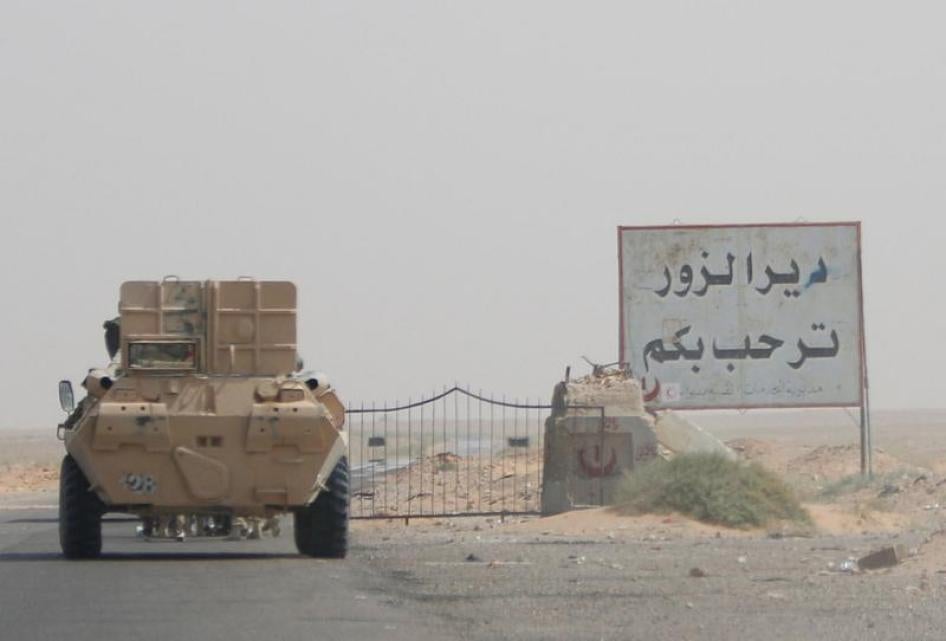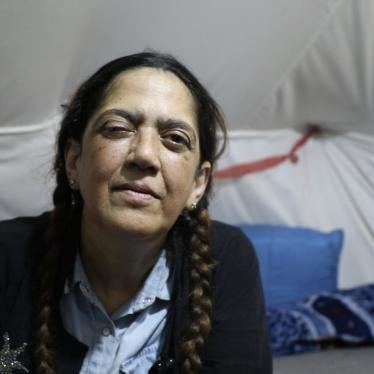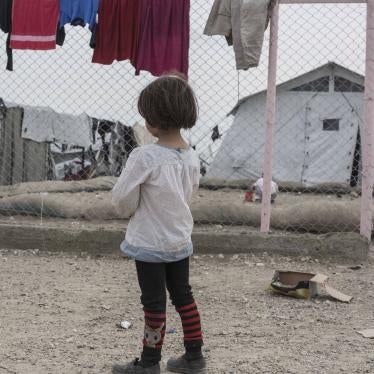(Beirut) – A group of civilians is stranded in the last remaining pocket under Islamic State (also known as ISIS) control in the city of Deir al-Zor, Human Rights Watch said today. All parties to the conflict, including the Syrian-Russian alliance and the Syrian Democratic Forces (SDF), that are surrounding the area should provide safe passage to the civilians to allow them to safely flee the fighting.
The Syrian-Russian military alliance has retaken control of most of Deir al-Zor city from ISIS. Two residents and three Syrian media and human rights monitors have confirmed to Human Rights Watch that a group of civilians is stuck in the Hweijet Qate` neighborhood, an island in the Euphrates river that remains under ISIS control. They said residents are unable to flee because ISIS members were preventing them from leaving, and Syrian government forces were shelling the area. The SDF has not made any efforts to actively provide a safe passage and has shelled the ISIS-controlled area previously, they said.
“All parties to the conflict should ensure that the protection of civilians remains central to the fight against ISIS,” said Nadim Houry, terrorism and counterterrorism director at Human Rights Watch. “Safe passage out for these stranded civilians should be a priority.”
The Russian-Syrian offensive on the city, which began in September 2017, has resulted in the death of at least 687 civilians, according to the Syrian Network for Human Rights, while thousands more have been displaced.
Hweijet Qate` was the last remaining area under ISIS control, as of November 14, in Deir al-Zor city, residents and activists said. ISIS fighters are interspersed among civilians, local organizations and activists reported. Syrian government forces control the southern banks of the Euphrates, while the SDF, consisting of the Kurdish People’s Protection Units (YPG) and other groups, controls areas north of the river.
On November 3, Syrian human rights and media organizations issued a call for assistance to the civilians in Hweijet Qate`, who they said were under threat from shelling by the SDF and the Syrian government, as well as the government forces advancing on the neighborhood.
On November 5, a resident of Hweijet Qate` told Human Rights Watch that some families remained on Hweijet Qate` in the midst of Syrian government bombardment from the southern banks of the Euphrates. “We have women and children here, their situation is very difficult,” the resident said. “It is cold and most of the children are without sustenance.”
Human Rights Watch has not been able to independently confirm the number of civilians remaining on Hweijet Qate’. On November 10 and 11, a local media activist reported that Syrian government forces’ shelling on Hweijet Qate` killed six people, including four women. Two more people were reported injured. On November 12, DeirEzzor 24, an opposition-affiliated online news outlet, posted a video it said was filmed from SDF-controlled areas showing shelling of Hweijet Qate` with heavy artillery. It said that the shelling was from Syrian government forces.
On November 10, Mustafa Bali, head of the SDF’s Media Center, told Human Rights Watch that the Syrian Democratic Forces had agreed to allow passage for civilians into SDF-controlled village, al-Husseinyeh, but that no civilians from Hweijet Qate` had yet arrived:
“As for those trapped on the island, all attempts to move them or allow them to move into our area has failed. Unfortunately, the difficulty is that the regime is still insisting on taking those people hostages, and striking randomly at the island.”
At least some of the stranded civilians had arrived from al-Huweiqa neighborhood, on the Western bank of the Euphrates after the Syrian government retook the neighborhood, said Justice for Life, a Syrian human rights monitoring group.
On November 3, two trapped residents in al-Huweiqa told Human Rights Watch by phone that they could see the Syrian government forces approaching, while airstrikes continued non-stop in the vicinity. Human Rights Watch staff could hear airplanes in the background during the conversations. A resident that had escaped to the neighborhood on November 1 said that approximately 250 civilians were in the neighborhood, including children. He also estimated that about 100 civilians had been injured. He said that while the majority of the people there were civilians, ISIS fighters were among the group as well. By November 9, government forces had retaken al-Huweiqa, Justice for Life reported.
The laws of war require all parties to the conflict to take all feasible steps to evacuate civilians from areas of fighting or where fighters or other military targets are deployed and not block or impede the evacuation of those wishing to leave. Human Rights Watch has previously documented that ISIS uses civilians to protect its forces from attack. Deliberately using the presence of civilians to protect military forces from attack is the war crime of “human shielding.”
All parties to the conflict should facilitate civilians’ right to flee from active conflict and anticipated persecution and should allow aid to reach them, Human Rights Watch said. Parties should take all feasible precautions to avoid, and in any event minimize, civilian casualties in the fighting, including refraining from the use of munitions, including barrel bombs, that are inherently indiscriminate or result in disproportionate harm to civilians. Both the SDF and the Syrian-Russian alliance should ensure that they do not persecute residents of previously ISIS-controlled areas on the basis of perceived ISIS affiliation, through prolonged, arbitrary detention, inhumane treatment, or extrajudicial executions.
“Those fleeing ISIS should not have to fear their future at the hands of the Syrian government or the SDF,” Houry said. “It is essential to respect due process and avoid any collective punishment for those who lived under ISIS.”







